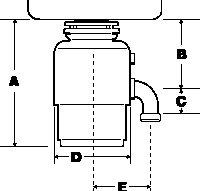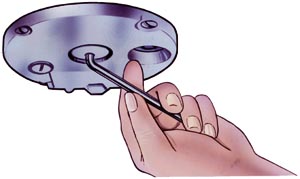1. Why need a food waste disposer?
2. What
can we grind in a food waste disposer?
3. Is
a food waste disposer safe to use?
4. My kitchen
is so small, can I still install a food waste disposer?
5. Do
I need a special sink?
6. Is a food waste disposer
easy to install?
7. Should my disposer become
jammed, can I still use my sink?
8. How reliable
are food waste disposers?
9. What happens if
something falls inside?
10. Are disposers noisy?
11. What maintenance does a food waste disposer require?
12. How much water and electricity does a food waste
disposer require?
"Why
need a food waste disposer?"
Recent studies indicate that
the importance of the kitchen as a focal point in the home, rather than a simple
work space, is increasing. Home builders state that consumers demand a kitchen
that is designed to be comfortable, relaxing and easy to maintain.
Of all
the rooms in the home, confidence in the kitchen's cleanliness adds to the homeowner's
feeling of the room being relaxing and comfortable. Food waste disposers complete
the kitchen in a number of ways:
- They eliminate messy dustbins and
dripping rubbish bags that soil kitchen floors & halls.
- They reduce the amount of food waste and plastic rubbish bags going to landfills, or being incinerated; so environmental protection can be achieved.
- They eliminate
the need to specially treat food waste. No scraps, no smells, no attraction for
insects. All at the touch of a button!
- They reduce chores such as taking
out the garbage and disinfecting the garbage cans.
- They are hygienic,
as food waste disposers eliminate major sources of germs in the kitchen.
"What
can we grind in a food waste disposer?"
Almost any household
waste can be ground in a food waste disposer. Examples of what can be ground include:
- Small bones, including fish, chicken, beef, and pork bones
-
Peach pits, apple cores, and orange peels
- Egg shells and nuts
-
Vegetable waste
- Meat and skin
- Rice and pasta
However,
there are some things that should not be ground in a disposer: - Fibrous
materials(celery,corn husks).These materials form hard fiber clusters which interfere
with the grinding elements.
- Clam shells and similar hard shells. These
items are hard enough to cause significant wear on the swivel lugs.
- Harsh
chemicals,hot oil or abrasive cleaning agents should not be used, as these cause
wear on the disposer mechanisms.
- Paper, plastic, metal, glass, or pottery
should not be ground for any reason.
"Is
a food waste disposer safe to use?"
Yes! The food waste disposer is one
of the safest home appliances. There is a common misconception that the food
waste disposer has blades or knives that chop up food. In reality, the food waste
disposer has swiveling lugs that, through centrifugal force, press food against
a grind ring inside the disposer's grind chamber. This grinding action reduces
the food waste to fine particles about the size of a match head. These particles
are then flushed down the sink drain.
"My
kitchen is so small, can I still install a food waste disposer?"
In-Sink-Erator
food waste disposers can be easily adapted to any type of sink, leaving room for
cleaning or other kitchen supplies. In-Sink-Erator's food waste disposers have
no unnecessary or superficial design elements to take up valuable storage space
under the sink. Although In-Sink-Erator disposers are surprisingly compact, there
can be situations where the smallest units (Model 45 or 55) are the most practical.
All In-Sink-Erator disposers fall somewhere within the following dimensions:
 |
|
A |
B |
C |
D |
E |
|
40.3 cm |
27.3 cm |
10.2 cm |
19.1 cm |
14.6 cm |
| |
32.1 cm |
17.9 cm |
10.2 cm |
21.0 cm |
15.0 cm |
| |
31.8 cm |
16.8 cm |
10.2 cm |
18.4 cm |
12.7 cm |
| |
31.8 cm |
16.8 cm |
10.2 cm |
17.3 cm |
12.7 cm |
| |
31.8 cm |
16.8 cm |
10.2 cm |
15.9 cm |
12.7 cm |
See product
information for complete details of all models.
"Do I need a special sink?"
In-Sink-Erator food waste
disposers can be installed under almost any type of sink, including: -
Stainless steel
- Porcelain
- Ceramic
Those
who have a sink with an opening that is larger or smaller than standard should
enlarge it with a special sink cutting tool which is available in hardware stores
and can be used by your local installer to adjust a small opening sink to the
standard 90mm (4.5 inch) opening.
"Is a food
waste disposer easy to install?"
Yes, in less than a few hours, an In-Sink-Erator
disposer can be installed in almost any home. Every model comes with detailed
instructions and can be installed by anybody who has basic do-it-yourself experience.
If you prefer, a local authorized In-Sink-Erator dealer can refer you to a
professional to perform the installation for you.
It is important to comply
with plumbing and electrical codes concerning proper installation.
For more
detail, see the installation procedures
in this online manual.
"Should my disposer become
jammed, can I still use my sink?"
Yes, you can. In the rare event that your food
waste disposer has a problem, water will still pass through, allowing you to continue
using your sink. - Disposer jams are very infrequent and are easily remedied.
-
For those rare occasions when a food waste disposer becomes jammed, In-Sink-Erator
provides a simple wrenchette that allows you to free the jam in one easy movement.
|  |
"How reliable are food waste disposers?"
Very
reliable. Every In-Sink-Erator model is totally guaranteed for at least one year,
but it is very rare that your food waste disposer will need service during the
warranty period (only 1 in 2500). - It is not rare to hear that In-Sink-Erator
food waste disposers operate perfectly even after 25 years.
- Should any
problems arise, do not hesitate to call an authorized In-Sink-Erator representative;
they will be glad to help.
"What happens
if something falls inside?"
If something falls inside that should not
be ground, turn off the disposer immediately. Make sure the disposer is off and
use a household utensil such as tongs to reach in and retrieve the object.
"Are disposers noisy?"
Most people
are impressed at finding that In-Sink-Erator food waste disposers are relatively
quiet (much more, in fact, than other appliances like a blender, for example).
In-Sink-Erator disposers are quieter than competitive models that do not feature
Dura-Drive(tm) induction motors. The higher-end In-Sink-Erator models contain
extra sound-proofing materials to lower the noise level even more. Combined with
larger sound barriers, superior insulation, and a secondary sound baffle, In-Sink-Erator
has created the Sound Reduction Systems:
| Name |
Trim Shell |
Insulation |
Quiet System |
Batch-Feed 78 |
standard |
Trim shell only |
Standard Quiet System |
| Model 75 |
extra large |
Double foam & rubber backing, double baffle |
Ultra Quiet II System |
| Model 65 |
large |
Superior foam insulation, double baffle |
Quiet Plus System |
| Model 55 |
standard |
Standard insulation |
Standard Quiet System |
| Model 45 |
none |
none |
Basic |
"What maintenance does a food waste
disposer require?"
- In-Sink-Erator models are designed and built
so they do not need any type of preventative maintenance. Just install it and
use it!
- If your disposer should become jammed, In-Sink-Erator provides
a self-service wrenchette that can free even the hardest jams with a few simple
turns.
- In-Sink-Erator models do not need oiling, as all bearings are
permanently sealed and lubricated.
"How
much water and electricity does a food waste disposer require?"
- The fast-grinding action of an In-Sink-Erator food waste disposer keeps
water use to the absolute minimum. The average usage is only 3.1 liters per
day per person, or a .04% increase in household water consumption.
- The average electric power consumption of a .55 HP food waste disposer
for one month is equal to the power consumption of a 100 watt light bulb for
one hour! (3.7 watts/hour)
Copyright © 2002 CONCORD ELECTRIC(HK)CO LTD. All
Rights Reserved.


